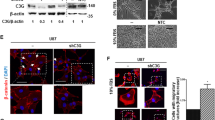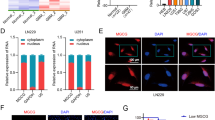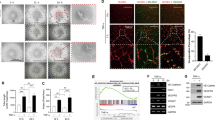Abstract
The ERK pathway is typically associated with activation of the EGF receptor and has been shown to play a major role in promoting several tumor phenotypes. An analogous signaling module, the JNK pathway, has not been shown to be consistently activated by the EGF receptor but is instead more uniformly stimulated by cellular stresses and cytokines. The function of the JNK pathway in primary tumors is unclear as it has been implicated in both promoting apoptosis and cell growth in vitro, which may be a reflection of the cell lines chosen. Primary human brain tumors frequently show overexpression of the EGF receptor. To clarify the role of JNK in tumorigenesis, we have investigated the role of JNK in a large panel of primary human brain tumors and tumor derived cell lines. Here we present evidence that JNK has a major role in promoting tumorigenesis both in vivo and in vitro. Western blot analysis demonstrated that 86% (18 of 21) of primary brain tumors showed evidence of JNK activation but only 38% (8 of 21) showed evidence of ERK activation. Kinase assays revealed that 77% of brain tumor cell lines activated JNK in response to EGF (7 of 13) or had high levels of basal activity (3 of 13), whereas none of six normal cell lines analysed, including astrocytes, had these properties. Of several growth factors examined, EGF produced the highest level of JNK induction in tumor cell lines and the duration of activation was greater than that seen for ERK. Expression of a dominant-negative (dn) form of JNK potently inhibited EGF mediated anchorage independent growth and protection from cell death in two glial tumor cell lines. These findings demonstrate that enhanced JNK activation is frequently found in primary brain tumors and that this activation contributes to phenotypes related to transformation.
This is a preview of subscription content, access via your institution
Access options
Subscribe to this journal
Receive 50 print issues and online access
$259.00 per year
only $5.18 per issue
Buy this article
- Purchase on SpringerLink
- Instant access to full article PDF
Prices may be subject to local taxes which are calculated during checkout





Similar content being viewed by others
References
Abreu-Martin MT, Chari A, Palladino AA, Craft NA, Sawyers CL . 1999 Mol. Cell. Biol. 19: 5143–5154
Almeida EA et al . 2000 J. Cell Biol. 149: 741–754
Antonyak MA, Moscatello DK, Wong AJ . 1998 J. Biol. Chem. 273: 2817–2822
Bost F, McKay R, Bost M, Potapova O, Dean NM, Mercola D . 1999 Mol. Cell. Biol. 19: 1938–1949
Bost F, McKay R, Dean N, Mercola D . 1997 J. Biol. Chem. 272: 33422–33429
Chen N, Nomura M, She QB, Ma WY, Bode AM, Wang L, Flavell RA, Dong Z . 2001 Cancer Res. 61: 3908–3912
Chen YR, Wang X, Templeton D, Davis RJ, Tan TH . 1996 J. Biol. Chem. 271: 31929–31936
Coso OA, Chiariello M, Yu JC, Teramoto H, Crespo P, Xu N, Miki T, Gutkind JS . 1995 Cell 81: 1137–1146
Derijard B, Hibi M, Wu IH, Barrett T, Su B, Deng T, Karin M, Davis RJ . 1994 Cell 76: 1025–1037
Hashimoto A, Kurosaki M, Gotoh N, Shibuya M, Kurosaki T . 1999 J. Biol. Chem. 274: 20139–20143
Hoshino R, Chatani Y, Yamori T, Tsuruo T, Oka H, Yoshida O, Shimada Y, Ari, Wada H, Fujimoto J, Kohno M . 1999 Oncogene, 18: 813–822
Kyriakis JM, App H, Zhang XF, Banerjee P, Brautigan DL, Rapp UR, Avruch J . 1992 Nature 358: 417–421
Kyriakis JM, Banerjee P, Nikolakaki E, Dai T, Rubie EA, Ahmad MF, Avruch J, Woodgett JR . 1994 Nature 369: 156–160
Logan SK, Falasca M, Hu P, Schlessinger J . 1997 Mol. Cell. Biol. 17: 5784–5790
Mandell JW, Hussaini IM, Zecevic M, Weber MJ, VandenBerg SR . 1998 Am. J. Pathol. 153: 1411–1423
Mansour SJ, Matten WT, Hermann AS, Candia JM, Rong S, Fukaswa K, Vande WG, Ahn NG . 1994 Science 265: 966–970
McClellan M, Kievit P, Auersperg N, Rodland K . 1999 Exp. Cell Res. 246: 471–479
Minden A, Lin A, Claret FX, Abo A, Karin M . 1995 Cell 81: 1147–1157
Minden A, Lin A, McMahon M, Lange-Carter C, Derijard B, Davis RJ, Johnson GL, Karin M . 1994a Science 266: 1719–1723
Minden A, Lin A, Smeal T, Derijard B, Cobb M, Davis R, Karin M . 1994b Mol. Cell. Biol. 14: 6683–6688
Moscatello DK, Montgomery RB, Sundareshan P, McDanel H, Wong MY, Wong AJ . 1996 Oncogene 13: 85–96
Okamoto I, Kawano Y, Murakami D, Sasayama T, Araki N, Miki T, Wong AJ, Saya H . 2001 J. Cell Biol. 155: 755–762
Olson MF, Ashworth A, Hall A . 1995 Science 269: 1270–1272
Potapova O, Gorospe M, Bost F, Dean NM, Gaarde WA, Mercola D, Holbrook NJ . 2000a J. Biol. Chem 276: 28546–28553
Potapova O, Gorospe M, Dougherty RH, Dean NM, Gaarde WA, Holbrook NJ . 2000b Mol. Cell. Biol. 20: 1713–1722
Potapova O, Haghighi A, Bost F, Liu C, Birrer MJ, Gjerset R, Mercola D . 1997 J. Biol. Chem. 272: 14041–14044
Qiu RG, Abo A, McCormick F, Symons M . 1997 Mol. Cell. Biol. 17: 3449–3458
Raitano AB, Halpern JR, Hambuch TM, Sawyers CL . 1995 Proc. Natl. Acad. Sci. USA 92: 11746–11750
Rodrigues GA, Park M, Schlessinger J . 1997 EMBO J. 16: 2634–2645
Sebolt-Leopold JS, Dudley DT, Herrera R, Van Becelaere K, Wiland A, Gowan RC, Tecle H, Barrett SD, Bridges A, Przybranowski S, Leopold WR, Saltiel AR . 1999 Nat. Med. 5: 810–816
Sivaraman VS, Wang H, Nuovo GJ, Malbon CC . 1997 J. Clin. Invest. 99: 1478–1483
Smeal T, Binetruy B, Mercola DA, Birrer M, Karin M . 1991 Nature 354: 494–496
Steck PA, Pershouse MA, Jasser SA, Yung WK, Lin H, Ligon AH, Langford LA, Baumgard ML, Hattier T, Davis T, Frye C, Hu R, Swedlund B, Teng DH, Tavtigian SV . 1997 Nat. Genet. 15: 356–362
Tan PB, Kim SK . 1999 Trends Genet. 15: 145–149
Teng DH, Perry WL, Hogan JK, Baumgard M, Bell R, Berry S, Davis T, Frank D, Frye C, Hattier T, Hu, Jammulapati S, Janecki T, Leavitt A, Mitchell JT, Pero R, Sexton D, Schroeder M, Su PH, Swedlund B, Kyriakis JM, Avruch J, Bartel P, Wong AK, Tavtigian SV . 1997 Cancer Res. 57: 4177–4182
Whitmarsh AJ, Davis RJ . 1996 J. Mol. Med. 74: 589–607
Wong AJ, Zoltick PW, Moscatello DK . 1994 Semin. Oncol. 21: 139–148
Xia Z, Dickens M, Raingeaud J, Davis RJ, Greenberg ME . 1995 Science 270: 1326–1331
Xing C, Imagawa W . 1999 Carcinogenesis 20: 1201–1208
Xu X, Raber J, Yang D, Su B, Mucke L . 1997 Proc. Natl. Acad. Sci. USA 94: 12655–12660
Author information
Authors and Affiliations
Corresponding author
Rights and permissions
About this article
Cite this article
Antonyak, M., Kenyon, L., Godwin, A. et al. Elevated JNK activation contributes to the pathogenesis of human brain tumors. Oncogene 21, 5038–5046 (2002). https://doi.org/10.1038/sj.onc.1205593
Received:
Revised:
Accepted:
Published:
Issue date:
DOI: https://doi.org/10.1038/sj.onc.1205593
Keywords
This article is cited by
-
Regulatory mechanism for the human glioblastoma cell-specific expression of the human GD1c/GT1a/GQ1b synthase (hST8Sia V) gene
Glycoconjugate Journal (2023)
-
RUNX1 Regulates Migration, Invasion, and Angiogenesis via p38 MAPK Pathway in Human Glioblastoma
Cellular and Molecular Neurobiology (2017)
-
Regulation of protein translation and c-Jun expression by prostate tumor overexpressed 1
Oncogene (2014)
-
Synergistic suppression of noscapine and conventional chemotherapeutics on human glioblastoma cell growth
Acta Pharmacologica Sinica (2013)
-
Dual modulation of JNK and Akt signaling pathways by chaetoglobosin K in human lung carcinoma and ras-transformed epithelial cells
Investigational New Drugs (2013)



